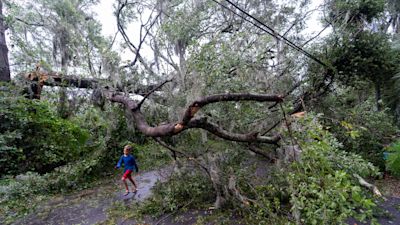Hurricane Ian: More than two million without power as hurricane moves into South Carolina

'We've had a lot of hurricanes, but we never had a thing like this,' one Fort Myers resident told ITV News US Correspondent Emma Murphy
Hurricane Ian has destroyed at least four piers along South Carolina’s northern coast after the deadly storm caused catastrophic damage in Florida and trapped thousands in their homes.
The brunt of the surge and waves from the storm hit around Myrtle Beach on Friday.
More than 200,000 customers were without power on Friday afternoon in South Carolina as Ian moved onshore. And more than 82,000 customers in North Carolina are in the dark, mostly in the south-central area of the state.
Ian has since dropped from a hurricane to a post-tropical cyclone as it moved across South Carolina.
At least nine people were confirmed dead in the US, a number that is almost certain to increase as officials confirm more deaths and search for people.
Among those killed were an 80-year-old woman and a 94-year-old man who relied on oxygen machines that stopped working amid power outages, as well as a 67-year-old man who was waiting to be rescued died after falling into rising water inside his home, authorities said.
At least three people were reported killed in Cuba after the hurricane struck there on Tuesday.
Today, communities in Florida are surveying the damage left in the wake of Hurricane Ian. Emma Murphy reports from Fort Myers.
Ian left a broad swathe of destruction after it came ashore on Florida’s Gulf Coast as one of the strongest storms ever to hit the US.
The storm flooded areas on both of Florida’s coasts, tore homes from their slabs, demolished beachfront businesses and left more than two million people without power.
Sheets of rain whipped trees and power lines in South Carolina, and many areas on Charleston’s downtown peninsula were already under water by midday local time.
Streets in the 350-year-old city were largely empty. Ian's anticipated landfall just up the South Carolina coast was expected to coincide with high tide, which would make flooding worse.
On Friday, President Biden spoke to those affected in a speech broadcast from the White House.
"I've directed that every possible action be taken to save lives and get help to survivors because every single minute counts," the president said.
"It's not just a crisis for Florida, this is an American crisis. We're all in this together."
He continued: "My message to the people of South Carolina is simple: Please listen to all the warnings and directions from local officials and follow their instructions. And as you all know, the situation in Florida is far more devastating."
In Florida, rescue crews piloted boats and waded through riverine streets on Thursday to save thousands of people trapped amid flooded homes and buildings shattered by Hurricane Ian.
Florida Governor Ron DeSantis said on Friday that rescue crews had gone door-to-door to over 3,000 homes in the hardest-hit areas.
“There's really been a Herculean effort,” he said during a news conference in Tallahassee.
Climate change added at least 10% more rain to Hurricane Ian, according to a study prepared immediately after the storm, said its co-author, Lawrence Berkeley National Lab climate scientist Michael Wehner.
In Florida, businesses near Fort Myers Beach were completely razed, leaving twisted debris. Broken docks floated at odd angles beside damaged boats. Fires smouldered on lots where houses once stood.
“I don't know how anyone could have survived in there,” William Goodison said amid the wreckage of a mobile home park where he'd lived for 11 years. Goodison rode out the storm at his son's house inland.
Hours after weakening to a tropical storm while crossing the Florida peninsula, Ian regained strength on Thursday evening over the Atlantic.
National Guard troops were being positioned in South Carolina to help with the aftermath, including any water rescues. And in Washington, President Joe Biden approved an emergency declaration for the state, a needed step to speed federal assist for recovery once Ian passes.
In North Carolina, Governor Roy Cooper urged residents to prepare for torrents of rain, high winds and potential power outages.
Want a quick and expert briefing on the biggest news stories? Listen to our latest podcasts to find out What You Need To Know